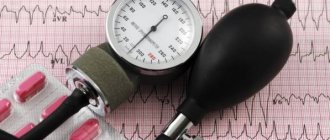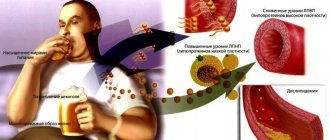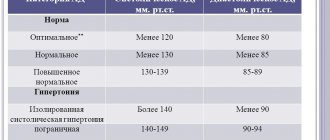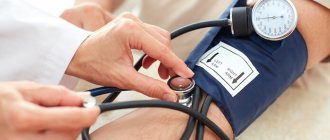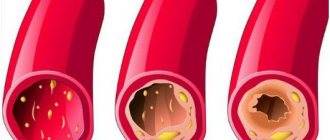Blood pressure is the difference between the force of blood on the vessels (primarily arteries) and atmospheric values.
A normal reading ranges from 100 to 139 over 60-89. Such a “standard” has long been established by the World Health Organization, based on rich empirical material.
Anything lower is hypotension, anything higher is the opposite process (hypertension). Both are dangerous, both need to be treated.
A blood pressure of 80 over 50 is considered low; according to the classification of the WHO and national cardiological communities (in particular Russian, Ukrainian), this is mild hypotension. In reality, the assessment may vary, but the process is obvious.
There is also a maximum lower limit of pulse pressure (the difference between systolic (upper) and diastolic (lower) indicators). Such hypotension requires routine diagnosis and therapy to avoid complications.
What does a tonometer level of 80/50 mean?
Such blood pressure numbers indicate problems in the body. But not always.
Physiological factors also occur, but their share in the total number of clinically significant situations is quite small, about 30%.
Diseases are much more common, the remaining 70% are problems with the heart, blood vessels, hormonal levels and nervous system, less often the kidneys and excretory tract.
Hypotension does not always carry the same danger. Patients with a chronic increase in blood pressure, as well as people whose normal working pressure is above 130 to 80, experience much greater discomfort, and such a tonometer reading for them is determined by a significant threat.
For your information: the likelihood of complications in patients with hypertension when blood pressure decreases is almost three times higher.
Is it dangerous?
Any strong deviations in blood pressure readings from the norm pose a certain danger. In the case of lower levels, the likelihood of developing various cardiac pathologies and vision problems increases. Also, with severe hypotension, there is a possibility of loss of consciousness, which often leads to various head injuries.
In addition, hypotension in general has a rather strong effect on the patient’s performance. A person with severe hypotension constantly experiences drowsiness, problems concentrating on various things, and persistent dizziness often occurs. Therefore, hypotension must be dealt with if it occurs constantly and leads to poor health.
Are these indicators normal during pregnancy?
Again, there is no definite answer. The gestational process differs in severity (toxicosis, fetal size, etc. play a role), and the individual characteristics of the body of a particular woman must also be taken into account.
During pregnancy, a decrease in blood pressure is quite possible, within wide limits. Blood pressure 80/50 is also likely, but whether this is normal or not will only be understood through constant monitoring of the condition.
If during the gestation period the numbers do not change or deviate minimally from the primary values, most likely we are talking about a physiological process. Otherwise, you need to look for the cause of the blood pressure surges.
The diagnosis, as a rule, is very difficult to make; it is often determined after the fact, when delivery has occurred. Within 2-3 weeks everything should return to normal. If this is not the case, an appropriate diagnosis is made.
Natural causes of low blood pressure
- Peak hormonal states.
Pregnancy has already been mentioned, but this is not the only process. Puberty or puberty in adolescents 12-19 years old. Accompanied by jumps in blood pressure, in this case the tonometer readings are unstable, it is necessary to evaluate the frequency of changes and their scale.
If levels vary between 10-30 mmHg, no assistance is required. But throughout the entire process it is worth seeing a cardiologist at least once a year.
Menstrual cycle. During the first and second phases, a slight persistent drop in blood pressure is possible. This is not observed in all women and is rather an individual feature of the body.
The climacteric process. Representatives of both sexes. It usually ends with an increase in blood pressure, but options are possible.
A blood pressure of 80 to 50 during pregnancy is possible, but the woman still needs to be monitored so as not to miss pathological changes that “grow profusely” due to gestation.
- Physical development of the body.
A typical condition for amateur and professional athletes. In addition to a decrease in blood pressure, a weakening of cardiac activity occurs.
The usual situation: blood pressure is 80 over 50 or less, heart rate is about 50 beats per minute. This phenomenon does not pose a danger to life and health, but has a downside: with prolonged absence of physical activity, the likelihood of cardiac arrest or heart attack is higher, since the organ gets used to functioning at an intense rhythm.
- Work in hazardous, hot industries.
Steel foundries, glass factories and the like. The body's adaptation to the unfavorable conditions of the surrounding artificial environment is affected.
If the body does not adapt, problems can be fatal. Such professional activity is not suitable for everyone; you need to evaluate your strengths. In addition, fatal complications are possible even among adapted workers.
- Hot, stuffy climate.
This applies to a greater extent to residents of the equatorial regions and areas close to them. But other patients also have the same protective mechanism, including some regions of Russia, Ukraine, and Kazakhstan that are unfavorable.
The process of lowering pressure is observed in people who are temporarily in unusually hot conditions. This is the so-called acclimatization. It develops in several stages and ends after 2-6 days.
Again, patients prone to problems with the cardiovascular system are not recommended to visit hot areas; it is dangerous and impractical; instead of relaxation, there is a risk of getting health problems and a significant deterioration in well-being.
- Meteor dependence. It manifests itself as both high and low blood pressure, it all depends on the individual characteristics of the body.
- Abuse of gestagenic drugs. Young women and the fairer sex are guilty of this during menopause.
- Incorrect use of antihypertensive drugs. The regimen, dosage, and the names themselves play a role. If the course is not prescribed correctly, the pressure will drop, which is fraught with complications.
Natural factors are relatively rare.
Diagnosis for hypotension
If hypotension is caused by negative external influences, then it is enough to simply eliminate the external factor and take an antihypotensive drug to eliminate it. However, if we are talking about chronic hypotension, then most likely its cause lies in internal pathological processes.
Hypotension caused by internal pathologies cannot be eliminated by symptomatic treatment alone. In this case, the patient's condition will constantly worsen. Therefore, when designing therapy, it is very important to take into account exactly what disease caused the deviation in the readings on the tonometer.
You also need to understand that with prolonged hypotension, pathologies in the internal organs may develop. And even if the condition normalizes, they will progress, worsening the patient’s condition.
That is why doctors, before prescribing treatment to their patients, conduct a thorough diagnosis of their condition. Various methods can be used for this.
Diagnostic methods used for hypotension:
- Usually the patient is prescribed daily monitoring of blood pressure and heart rate. This examination is carried out in a hospital, where the doctor records the indicators he needs using sensors attached to the patient’s body.
- ECG. It can be used to check the correct functioning of the heart. Based on the results of such diagnostics, further examinations are prescribed.
- MRI and CT. These diagnostic methods are necessary to check the condition of organs that may cause low blood pressure. First of all, this method examines the pituitary gland and other parts of the brain.
- Ultrasound. This examination option is considered the most suitable for considering the condition of the heart, kidneys and adrenal glands.
- Stool examinations. This material is usually analyzed for the presence of blood particles if a bleeding ulcer or hemorrhoid is suspected.
- Blood and urine analysis. Blood and urine are examined for signs of inflammation, hormones, and microelements.
These are basic studies that are carried out at low pressure. However, the doctor may prescribe additional diagnostic options to clarify the details of the diagnosis.
Pathological causes
The list of possible diseases includes:
- Problems with the heart itself. A common option. Congenital and acquired defects, long-term hypotension, cardiosclerosis after myocardial infarction, mitral valve stenosis and other conditions. Despite their diversity, they are accompanied by almost the same symptoms: chest pain, shortness of breath, arrhythmia such as tachycardia, bradycardia, or changes in the time between each subsequent beat. Many defects do not manifest themselves at all; the only sign of the condition is cardiac arrest.
- Atherosclerosis of the aorta and its branches. Other vascular problems affecting the pulmonary and renal arteries. Accompanied by both a fall and an increase in blood pressure to significant levels and 80/50 mm Hg. Art. not the limit. There are no symptoms other than some interruptions in the functioning of the heart.
- Endocrine pathologies. Hypothyroidism (lack of thyroid hormones), hypocortisolism (cortisol deficiency). Both are the result of tumors, operations performed, and congenital anatomical defects. Symptoms are varied: in addition to a decrease in blood pressure, hypothermia, weakness, drowsiness, and changes in body weight also occur. Treatment by an endocrinologist.
- Kidney problems. The list of diseases is wide, the reason for the drop in blood pressure levels lies in a violation of fluid removal on the one hand, and on the other in a decrease in the concentration of renin in the blood (it is involved in regulating vascular tone along with other substances: aldosterone and angiotensin-II).
The symptoms are approximately the same: lower back pain, polyuria (increased daily urine output), the reverse process, frequent false urges to visit the toilet.
- Hepatitis or cirrhosis of the liver. The synthesis of a special prehormone is disrupted. Hence the impossibility of normal regulation of vascular tone. Manifestations are typical: pain in the right side, bitterness in the mouth, discoloration of feces, yellowness of the skin.
The causes of pressure 80 to 50 are pathological in 70% of cases, the remaining 30% are due to natural factors presented.
The assessment is carried out by a team of doctors after diagnosis. In the absence of data for organic damage to systems, physiological factors are sought.
What to do?
Therapy, if a person’s blood pressure is 80 to 50, is aimed at eliminating the causes that could provoke this pathology. First of all, you need to change your lifestyle, get rid of bad habits, and avoid stress. You also need to change your diet, eliminate fatty, fried, salty and spicy foods, and eat more vegetables and fruits. It is important to get enough sleep, not to be overtired and not to take tonic drinks. If a person suddenly becomes ill, it is recommended to place the patient on a horizontal, flat surface with his legs slightly elevated. You can bring cotton wool soaked in ammonia to his nose. If the patient is conscious, brew strong sweet tea and give it to drink. A pressure of 70/50 poses a threat to the patient’s life and therefore it is necessary to call an ambulance or take the person to the hospital.
For hypotension, if the pressure is 85 to 55, tonic drugs are used. These include caffeine and products that contain it. Tinctures of eleutherococcus and ginseng will be useful, helping to raise blood pressure and general toning of the body. You can use the homeopathic remedy "Tonginal", which restores blood pressure and pulse to normal values, while improving vascular tone. “Acepar”, “Citramon”, “Pentalgin”, “Pantocrine” and other drugs will help eliminate unpleasant symptoms.
The pulse with hypotension is most often accelerated.
Folk remedies
Non-traditional treatment is used only in combination with medication. It is completely harmless, and the means used are widely available to all categories of the population. As therapy, it is recommended to make herbal infusions that stimulate the nervous system and cause blood vessels to contract. Also, people suffering from hypotension are recommended to drink green tea in the morning, which contains a sufficient amount of caffeine and is harmless. This recipe is especially suitable for pregnant women. It is useful to consume freshly squeezed juices, which can be made at home. It is important to monitor the water-salt balance, because low blood pressure of 80 to 70 is an indication for salt intake and may mean a lack of it in the body.
Normal blood pressure in a healthy person who does not have any heart problems is considered to be 120/80. A blood pressure of 80/50 is low and is called hypotension, resulting in dizziness and weakness. There is a decrease in systolic and diastolic indicators. Both values are very important for establishing the physiological state of a person and can indicate diseases of the cardiovascular system. Therefore, with such indicators, you should seek help from a specialist.
How can you raise blood pressure at home?
This is not so difficult to do, but you need to strictly follow the algorithm:
- Measure your blood pressure level and record the numerical value.
- Take a caffeine tablet, maybe two. In the absence of this, Citramon will be used, but it is more dangerous due to the presence of paracetamol in the composition. Both drugs should be in your home medicine cabinet.
- Drink a tonic drink of your choice, you can have strong tea, one or two cups.
- Take a horizontal position, relax and do not make sudden movements to avoid a further drop in blood pressure according to the orthostatic pattern.
If after 20 minutes there is no effect, take tincture of eleutherococcus (one teaspoon), ginseng (30 drops). If you don't have it, lemon with cinnamon and honey in the amount of 3 teaspoons will do.
If after all the actions the blood pressure remains the same, you need to call an ambulance.
We are definitely not talking about a physiological phenomenon. There is a pathogenic process. We need to figure out which one it is.
What to avoid:
- Physical activity.
- Drugs that lower blood pressure (beta blockers, ACE inhibitors, antiarrhythmic drugs and others).
- Hot baths, contrast showers.
- Alcohol.
How to stabilize blood pressure
Low blood pressure 80/50 can lead to adverse consequences for human health, so the corresponding symptoms should not be left without proper attention. First, if you notice the above symptoms, you should contact your local doctor. He will conduct an examination and, if necessary, prescribe tests and additional research methods. Based on the results obtained, he will select the optimal course of treatment. Let's look at what you can do to eliminate low blood pressure.
Medications
Medicines should be taken with caution, in strict accordance with the doctor's prescription. The most effective of them:
- Citramon;
- Cordiamine (drops);
- Caffeine-Sodium Benzoate;
- Ginseng (tincture);
- Eleutherococcus (tincture);
- Glycine;
- Nootropic;
- Midodrine.
What symptoms should you see a doctor for?
You need to go to a cardiology specialist even if you have suspicions and a slight deterioration in your health.
Some manifestations are worth paying special attention to:
- Headache of unknown origin. Against the background of regular hypotension, it constantly exists. Localized in the back of the head or parietal region, it pulsates and pulsates in time with the beat of the heart.
- Vertigo. Inability to orientate normally in space due to vestibular disorders.
- Nausea and vomiting. They are relatively rare and quite intense when present.
- Drowsiness, weakness. Indicates a decrease in the intensity of brain trophism. Darkening in the eyes.
- Fainting. Especially repeated ones.
- Various types of heart rhythm disturbances.
This is about going to the doctor. If at least one of these manifestations is present, you need to call an ambulance:
- Intense headache, unbearable.
- Chest discomfort.
- Problems with speech, vision or hearing.
- Paresis, paralysis.
- Facial distortion.
A blood pressure level of 80-85 to 50-55 gives symptoms in 80% of cases, and dangerous manifestations in 15% of situations.
Signs of low blood pressure
The main consequences of this condition are associated with impaired blood circulation in the vascular system of the brain. The person will feel unwell, there will be pain (throbbing) in the temples, and in some cases in the occipital region. Patients note the occurrence of unpleasant sensations in the forehead, nagging pain in the temporal region. Migraine-like pain may occur on one side of the head. These phenomena are constant and dull in nature; nausea and vomiting may be added. The following are signs of low blood pressure:
- Significant deterioration in health when the weather changes, during magnetic storms.
- Hypotonic people suffer from rapid fatigue, weakness, and their performance is noticeably reduced by the end of the day.
- When suddenly rising from bed or chair, darkening and dizziness appear in the eyes;
- Very low blood pressure can cause fainting;
- Hypotonic patients complain of memory impairment and absent-mindedness. Due to a decrease in blood flow, a person with low blood pressure tends to experience depression, increased irritability, and mood swings.
- A decrease in vascular tone can lead to abnormalities in the functioning of the heart muscle. Both the heart itself and behind the breastbone may hurt. Such symptoms are accompanied by palpitations that are not associated with physical or nervous stress.
- With severely low blood pressure, a person constantly experiences a lack of air, often yawns, and experiences drowsiness.
- Hypotonics are very sensitive to heat or cold; they are characterized by coldness, numbness of the arms and legs.
Possible consequences
Among the complications:
- Myocardial infarction. Acute necrosis of cells of the muscular structures of the heart. It begins abruptly and quickly leads to irreversible changes and a fatal decrease in organ activity. Requires treatment. Even if successful, heart failure develops, which leads to death within 3-5 years without complex therapy.
- Stroke. Malnutrition of brain structures. Ischemic type. Hemorrhage is not common. It can also be fatal in the short term.
- Injuries due to falls. Fainting can happen at the most crucial moment. Therefore, patients with uncompensated hypotension should not drive. It is better not to visit potentially dangerous places.
- Cognitive impairment. Decreased memory, attention. Speed and productivity of thinking. The risk of Parkinson's and Alzheimer's diseases also increases (by approximately 6-8%).
- IHD and dysfunctional disorders.
Prevention of complications is one of the main goals of therapy.
Signs of chronic hypotension
A decrease in blood pressure leads to organ hypoxia - oxygen starvation. First of all, nerve cells react to this. Chronic hypotension affects the functional capacity of the brain.
Manifested by the following symptoms:
- dizziness,
- memory loss,
- the body reacts to a decrease in pressure by increasing the pulse rate to 80 or higher,
- fainting,
- heart failure,
- headache,
- visual impairment,
- decreased performance,
- rapid fatigue with minor physical and mental stress,
- flickering of flies before the eyes.
Following this, the filtration function of the kidneys decreases. As a result, less urine is produced, and undetected waste accumulates in the blood, poisoning the body. Swelling appears under the eyes and the face swells.
With hypotension, people feel tired even when they wake up in the morning after a normal sleep. Throughout the day they try to replenish energy with tonic drinks.
Necessary examinations
They are carried out under the supervision of a cardiologist. It is possible to involve other specialists: endocrinology, excretory system, etc. Comprehensive diagnostics includes the following activities:
- Recording patient complaints, objectifying symptoms.
- Collecting anamnesis, including family history, to identify the causes of the pathological process.
- Measurement of blood pressure in the arms and legs at intervals of several tens of minutes. It is better to carry out in a hospital to obtain more accurate data.
- Daily monitoring using an automatic tonometer. Allows you to evaluate the dynamics of blood pressure in normal, familiar living conditions.
- Electrocardiography. For the diagnosis of heart defects and disorders of the functional activity of the organ.
- Echocardiography. Necessary to detect changes in cardiac structures. This is the most accurate method.
- Study of the state of blood flow in the brain. Dopplerography of blood vessels.
- Blood tests for hormones, general and biochemical.
- If necessary, angiography, MRI, CT.
- Ultrasound of the kidneys.
In the absence of evidence for organic pathology, natural factors are sought. If there is neither one nor the other, we are talking about an idiopathic form of hypotension.
Low blood pressure in pregnant women
Hormonal instability during pregnancy leads to a decrease in indicators. This occurs due to severe toxicosis, heart pathologies, stressful situations, vegetative-vascular dystonia, and ulcers.
A pregnant woman's blood pressure drops in the 2nd-3rd semester due to an uncomfortable position during sleep. It is better for a woman not to sleep on her back, because the fetus compresses the vena cava and blood circulation is impaired.
Hypotension in an expectant mother is dangerous for the baby - the fetus suffers from a lack of oxygen and nutrients, it develops pathological damage in the heart, and the likelihood of birth defects increases. At the same time, labor ability is reduced and a caesarean section is often necessary.
In children under 7 years of age, a value of 80 to 50 is normal, unless a deterioration in general well-being is noticed. Sometimes these indicators indicate infectious diseases or overwork.
Methods of therapy
Treatment is systematic and comprehensive. It is carried out using several methods.
Use of medications
- Cerebrovascular drugs. Improves cerebral circulation and heart trophism. Piracetam, Actovegin.
- Nootropics. Normalize metabolism in cerebral structures. Glycine.
- Midodrine and its analogs. Constrict blood vessels, increase blood pressure.
- Caffeine and preparations based on it. Including Citramon, but with caution.
The selection is carried out by a doctor; a group of medications is usually prescribed, rather than just one single remedy.
Folk remedies
- Eleutherococcus (2 teaspoons 2 times a day).
- Tansy decoction (200 grams of raw material per 500 ml of water, drink a glass a day).
- Ginseng tincture (35-40 drops per day).
- Lemon with cinnamon and honey. No more than 6 tablespoons per day.
This is not the main method of therapy, only an addition that should enhance the effect.
Lifestyle change
- Quitting smoking, alcohol and drugs (even more so).
- Walking, physical activity (minor, 2 hours a day).
- Salt no more than 10-12 grams per day.
- Sleep - 8 hours per night.
Proper nutrition.
Can:
- Cereals, porridge.
- Vegetables fruits.
- Berries.
- Kissels, fruit drinks.
- Jelly.
- Natural sweets.
- Nuts, dried fruits, honey.
- Tea.
- Coffee.
- Lean meat and soups.
- Bread.
It is forbidden:
- Fried foods.
- Smoked meats.
- I'll bake it.
- Canned food.
- Semi-finished products.
- Pork, beef.
The diet is adjusted with a nutritionist.
How to deal with the problem?
If hypotension develops in a healthy person due to excessive stress and stressful situations, these negative factors should be eliminated, and within a few hours or days everything will return to normal.
Often blood pressure decreases due to anemia, pathologies of the nervous system and thyroid gland. In this case, the disease that caused the hypotension is treated directly.
A healthy lifestyle plays a big role in normalizing blood pressure. The following rules must be adhered to:
- Take frequent walks in fresh air.
- Stick to moderate physical activity.
- Take a daily contrast shower.
- Eat a balanced diet.
- Night sleep should last at least 8 hours.
If, despite a decrease in blood pressure to 80/40, a person feels unwell, it is necessary to urgently call a doctor . While waiting, you can offer the patient a glass of sweet tea or coffee, or a few drops of tincture of radiola rosea, lemongrass or eleutherococcus.
Raising blood pressure and keeping it at the required level is often much more difficult than lowering it.
Prevention
Preventive measures to maintain normal blood pressure should be taken by all categories of people, regardless of whether the person is prone to hypotension or hypertension.
A few important principles:
- Compliance with the work and rest regime.
- Maintaining physical activity, combating physical inactivity, and be sure to do a set of morning exercises.
- A full night's sleep of at least 8 hours.
- A balanced diet with sufficient intake of vitamins, minerals and protein.
- Regular walks in the fresh air.
- Hardening using a contrast shower.
Natural pomegranate and grape juices, compotes from rose hips, rowan berries, lingonberries, and dried apricots help increase hemoglobin and normalize blood pressure.
Hypotonic patients are not recommended to get out of bed quickly in the morning , so as not to provoke a sharp drop in pressure. You need to lie in bed for a couple of minutes, then take a sitting position for another minute, and only then get up.
Read on our website what to do if your blood pressure is: 80 over 40 , 80 over 60 , 90 over 60 and 90 over 70 ?
Symptoms
The patient's condition with pathological hypotension changes noticeably; in some situations, a pressure of 80/50 forces hospitalization. This is determined by the individual characteristics of the body and well-being. When such a manifestation appears in a hypertensive patient, an ambulance must be urgently called. A sudden jump is very dangerous and can lead to a heart attack or stroke.
Severe blood pressure leads to severe pain in the back of the head and difficulty breathing. Attacks can occur in large crowds of people, in stuffy rooms.
When the pressure drops, the following symptoms may occur:
- heartbeat disturbance,
- dizziness, fainting,
- increased sweating,
- nausea, vomiting,
- lack of air,
- increased heart rate,
- chills,
- drowsiness, weakness,
- limbs are always cold, numbness is possible,
- shortness of breath even with mild physical exertion.
Against the background of such signs, a person develops a depressive state, it is difficult for him to be present in noisy companies, he becomes aggressive, and a lack of oxygen causes frequent yawning.

